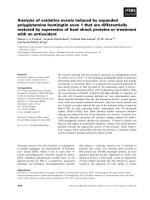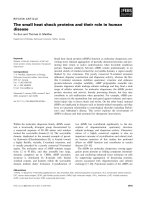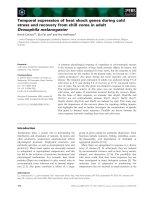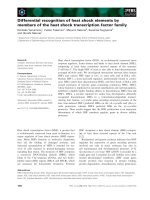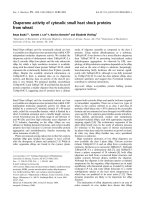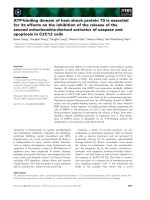Immunomodulatory roles of heat shock proteins
Bạn đang xem bản rút gọn của tài liệu. Xem và tải ngay bản đầy đủ của tài liệu tại đây (1.65 MB, 152 trang )
IMMUNOMODULATORY ROLES OF
HEAT SHOCK PROTEINS
BY
NG KIAN HONG (BSc. Hons)
A THESIS SUBMITTED
FOR THE DEGREE OF MASTER OF SCIENCE
NATIONAL UNIVERSITY OF SINGAPORE
2004
1
ACKNOWLEDGEMENTS
First and foremost, I would to like to extend my gratitude to my supervisor, Dr
Gan YH for her brilliant and excellent supervision, and for her unreserved guidance and
advice.
To Soh Chan, for her excellent technical assistance and comforting words.
To all the members and colleagues in the lab, for accompanying me through out
the course of my study.
To Dr Leslie, Jeremy, James and Sean from the AHU, and Ms Huang C-H from
Prof Chua KY’s lab, for their help in the animal studies.
To Karen, Weiping and Huang Bo, for their assistance in DNA sequencing.
To Dr Lu and Jason, for their help and discussion in TLR4 experiments.
To Soon Yew and Kok Seong, for their wonderful help, advice and friendship.
To Paul, Sherry, Jia Ling, Yong Mei, Annette, Qian Feng and Ying Ying, for their
encouragement and help in one way or the other.
To my aunt, uncle and my cousins, for their kindness and generous assistance.
Last but not least, I am eternally grateful to my parents and sister for believing
and supporting me at all times.
2
TABLE OF CONTENTS
TITLE PAGE
1
ACKNOWLEDGEMENTS
2
TABLE OF CONTENTS
3
LIST OF FIGURES
9
CHAPTER I
CHAPTER II
GENERAL INTRODUCTION
13
HSPs in antigen processing and cross-presentation
15
HSPs as ‘danger signals’
17
The regulatory role of HSPs
18
Aims of the project
19
THE IMMUNOLOGICAL ROLE OF BURKHOLDERIA
PSEUDOMALLEI HSP60, HSP70 AND MYCOBACTERIUM
BOVIS HSP65 IN VITRO
21
INTRODUCTION
22
MATERIALS AND METHODS
24
Cell lines
24
Generation of bone marrow-derived dendritic cells (BMDC) 25
Purification of heat shock proteins under native conditions
25
SDS-PAGE and Coomassie Blue staining
27
3
Synthetic peptides
27
In vitro antigen presentation assay and peptide pulsing
27
experiment
Flow cytometry analysis of CD54 expression
28
Measurement of cytosolic calcium
28
In vitro stimulation assay
29
Toll-like receptor 4 (TLR4) activation assay
29
RESULTS
31
Purification of recombinant heat shock proteins under
31
native condition
B. pseudomallei Hsp60 and 70 enhanced cross-
31
presentation of exogenous ovalbumin on DC2.4 to T cell
hybridoma, B3Z.
B. pseudomallei Hsp60 and 70 may enhance antigen
32
cross-presentation in BMDC.
The role of B. pseudomallei Hsp70 and Hsp60 in the
32
presentation of the short Ova peptide SINNFEKL.
B. pseudomallei Hsp70 and Hsp60 are not able to
33
up-regulate CD54 expression or induce calcium influx in DC.
4
B. pseudomallei Hsp60 and 70 are not able to
33
stimulate DCs to secrete TNF-α in the presence of LPS inhibitor.
B. pseudomallei Hsp70 and Hsp60 are not able to activate
34
TLR4 in the presence of LPS inhibitor.
DISCUSSIONS
CHAPTER III
55
EVALUATION OF IMMUNOGENICITY AND
ADJUVANCITY OF BURKHOLDERIA PSEUDOMALLEI
HSP70 AND MYCOBACTERIUM BOVIS HSP65 IN
MICE
61
INTRODUCTION
62
MATERIALS AND METHODS
64
Protein preparations
64
Mice
64
Intranasal immunization
64
Blood and nasal wash collections
65
Detection of serum and nasal wash antibodies
65
Spleen and lymph nodes cells preparation
67
In vitro stimulation assay and cytokines detection
67
Statistical Analysis
68
5
RESULTS
69
B. pseudomallei Hsp70 induces substantial systemic IgG
69
and mucosal IgA response in mice after intranasal immunizations.
Splenocytes and lymph nodes cells of Hsp70-immunized
69
mice produced IL-10 but not IFN-γ upon re-stimulation by Hsp70.
M. bovis Hsp65 induces systemic IgG and mucosal IgA
70
response in mice after intranasal immunizations.
Splenocytes and lymph nodes cells of Hsp65-immunized
70
mice produce IL-10 but not IFN-γ upon re-stimulation with Hsp65
Enhanced IL-10 production in spleenocytes and lymph
71
nodes cells from ovalbumin/Hsp70-immunized mice upon
re-stimulation with ovalbumin.
DISCUSSIONS
CHAPTER IV
80
CLONING AND EXPRESSION OF HUMAN HSP72,
MYCOBACTERIUM BOVIS HSP65, BURKHOLDERIA
PSEUDOMALLEI HSP70 AND HSP60 PROTEINS IN
DROSOPHILA EXPRESSION SYSTEM
84
INTRODUCTION
85
MATERIALS AND METHODS
87
6
Cloning primers
87
DNA templates
87
Polymerase chain reaction (PCR) amplification of heat
88
shock protein genes
DNA gel electrophoresis and extraction
89
Cloning of heat shock protein genes into pGEM-T Easy
90
vector
Restriction enzyme digestion analysis and DNA Sequencing 91
Sequencing primers
91
Cloning of heat shock protein genes into pAc5.1A
92
expression vector
Transient transfection of pAc5.1A-Hsp constructs into
93
drosophila S2 cells
Stable transfection of pAc5.1A-Hsp constructs into
93
drosophila S2 cells
Western blot analysis of proteins expression
94
RESULTS
96
Cloning of human Hsp72 into pAc5.1A expression vector
96
Cloning of M. bovis Hsp65 into pAc5.1A expression vector 96
7
Cloning of B. pseudomallei Hsp70 into pAc5.1A
97
expression vector
Cloning of B. pseudomallei Hsp60 into pAc5.1A
97
expression vector
Expression of human Hsp72 in drosophila S2 cells
98
Expression of B. pseudomallei Hsp70 in drosophila S2 cells 98
Transient expression of B. pseudomallei Hsp60 in
98
drosophila S2 cells
DISCUSSIONS
138
SUMMARY AND CONCLUSIONS
139
REFERENCES
141
8
LIST OF FIGURES
Figure
Titles
Page
2-1
Purification of recombinant (A) B. pseudomallei Hsp70,
35
(B) Hsp60 and (C) M. bovis Hsp65 under native condition.
2-2
Enhanced ovalbumin cross-presentation by (A) Hsp70
37
(B) Hsp60 and (C) Hsp65.
2-3
(A) Hsp70, (B) Hsp60 and (C) Hsp65-mediated ovalbumin
39
cross-presentation is not affected by polymyxin B (PMB),
the LPS inhibitor.
2-4
Enhanced antigen cross-presentation by (A) Hsp70
41
(B) Hsp60 and (C) Hsp65 in BMDC.
2-5
(A) Hsp70, (B) Hsp60 and (C) Hsp65-mediated antigen
43
cross-presentation in BMDC is not affected by PMB.
2-6
Effect of (A) Hsp70, (B) Hsp60 and (C) Hsp65 upon pulsing of 45
SL8 onto DC2.4.
2-7
Effect of (A) Hsp70, (B) Hsp60 and (C) Hsp65 upon pulsing of 47
EK18 onto DC2.4.
2-8
Hsp70, Hsp60 and Hsp65 do not up-regulate the expression
of CD54 on DC2.4.
9
49
2-9
Hsp70, Hsp60 and Hsp65 do not induce calcium influx in
51
DC2.4.
2-10
(A) B. pseudomallei Hsp70 and (B) Hsp60 are not able
52
to activate dendritic cells to secrete TNF-α in the presence of
PMB.
2-11
B. pseudomallei Hsp70 and Hsp60-mediated activation of
54
TLR4 is abolished in the presence of PMB.
3-1
B. pseudomallei Hsp70 induces substantial systemic
72
IgG and nasal IgA production upon intranasal immunization.
3-2
IgG isotyping of serum anti-B. pseudomallei Hsp70 antibody.
73
3-3
Enhanced IL-10 production in lymph nodes cells (A) and
74
splenocytes (B) of Hsp70-immunized group upon re-stimulation
with Hsp70.
3-4
M. bovis Hsp65 induces systemic IgG and nasal IgA
75
production upon intranasal immunization.
3-5
IgG isotyping of serum anti-M. bovis Hsp65 antibody.
76
3-6
Enhanced IL-10 production in lymph nodes cells (A) and
77
splenocytes (B) of Hsp65-immunized group upon re-stimulation
with Hsp65.
10
3-7
Enhanced IL-10 production in lymph nodes cells (A) and
78
splenocytes (B) of ovalbumin/Hsp70-immunized group upon
re-stimulation with ovalbumin.
3-8
IL-10 production in lymph nodes cells (A) and splenocytes (B) 79
of ovalbumin/Hsp65-immunized group upon re-stimulation with
ovalbumin.
4-1
Restriction enzyme digestion of pGEM-T-Hsp72 (4.9 kb).
99
4-2A
Schematic representation of pAc5.1A-Hsp72 construct.
100
4-2B
Nucleotide sequence analysis of human Hsp72 gene and the
101
corresponding amino acid sequence.
4-3
PCR verification of pAc5.1A-Hsp72 clone.
106
4-4
Restriction enzyme analysis of pGEM-T-Hsp65 clone.
107
4-5A
Schematic representation of pAc5.1A-Hsp65 construct.
108
4-5B
Nucleotide sequence analysis of M. bovis Hsp65 gene and
109
the corresponding amino acid sequence.
4-6
Restriction enzymes analysis of pAc5.1A-Hsp65 clone.
114
4-7
PCR amplification of full-length B. pseudomallei Hsp70
115
gene (1.95 kb).
4-8
Restriction enzyme analysis of pGEM-T-Hsp70 clone.
11
116
4-9A
Schematic representation of pAc5.1A-Hsp70 construct.
117
4-9B
Nucleotide sequence analysis of B. pseudomallei Hsp70 gene 118
and the corresponding amino acid sequence.
4-10
PCR verification of pAc5.1A-Hsp70 clone.
123
4-11
PCR amplification of full-length B. pseudomallei
124
Hsp60 gene.
4-12
Restriction enzyme analysis of pGEM-T-Hsp60 clone.
125
4-13A
Schematic representation of pAc5.1A-Hsp60 construct.
126
4-13B
Nucleotide sequence analysis of B. pseudomallei Hsp60 gene 127
and the corresponding amino acid sequence.
4-14
PCR verification of pAc5.1A-Hsp60 clone.
132
4-15
Expression of human Hsp72 recombinant protein
133
(75.7 kDa) in S2 cells.
4-16
Expression of B. pseudomallei Hsp70 recombinant protein
135
(75.4 kDa) in S2 cells.
4-17
Expression of B. pseudomallei Hsp60 recombinant protein
(65.3 kDa) in S2 cells.
12
137
CHAPTER I
GENERAL INTRODUCTION
13
It has been 42 years since the heat shock response was first reported in a
Drosophila study [Ritossa, 1962]. The heat shock proteins (HSPs) are highly conserved
proteins that are expressed constitutively and inducibly under stressful conditions like
heat shock, free oxygen radicals damage, ultraviolet damage and bacterial infections.
They can be found in a wide variety of subcellular compartments like cytosol, nucleus,
endoplasmic reticulum and mitochondria. HSPs can be divided into several families
including HSP100, HSP90, HSP70, HSP60, HSP40 and the small HSPs. HSPs act as
molecular chaperones to facilitate the synthesis, folding [Hartl, 1996; Gething and
Sambrook, 1992] and degradation of proteins [Parsell and Lindquist, 1993], to
resolubilise proteins aggregates [Ning and Sanchez, 1995], to assist in the refolding of
denatured proteins [Schlesinger, 1990] and the transport of proteins across intracellular
membranes [Morimoto, 1993]. HSPs first caught the attention of immunologists when
they were shown to play a role in antigen processing and cross-presentation [Udono et
al., 2001; Udono and Srivastava, 1993]. Subsequently, HSPs were reported to act as
“danger signals” to the innate immune system, in which they promote differentiation
and up-regulation of co-stimulatory molecules in antigen presenting cells (APC)
[Singh-Jasuja et al., 2001; Somersan et al., 2001]. Furthermore, scientists in the field of
autoimmunity had discovered the regulatory role of HSPs in inflammation [Prakken et
14
al., 2002; Prakken et al., 1997].
HSPs in antigen processing and cross-presentation
Srivastava and colleagues have made an important contribution to the discovery
of the role of HSPs in cancer immunity, particularly in the processing and
cross-presentation of antigen [Srivastava and Amato, 2001; Srivastava et al., 1998;
Srivastava, 1993; Srivastava and Maki, 1991]. Exogenous antigens are normally taken
up by the antigen presenting cells through endocytic pathway and presented by MHC
class II molecules. However, in professional APC like dendritic cells, the exogenous
antigen can be delivered into MHC class I processing and presentation pathway, a
phenomenon termed antigen cross presentation. They found that autologous HSP-tumor
peptide complexes could elicit specific immune responses leading to tumor rejection
[Basu et al., 1999; Li and Srivastava, 1993; Udono and Srivastava, 1993]. In fact, some
studies have used the autologous tumor-derived HSP-peptide complexes as a means of
immunotherapy [Tamura et al., 1997; Janetzki et al., 2000; Eton et al., 2000; Belli et al.,
2002]. The mechanism of HSP-peptide-induced immunity is proposed to happen in the
following manner: HSP mediates the transfer of exogenous peptides onto the major
histocompatibility (MHC) class I molecule of antigen presenting cells (APC),
particularly in dendritic cells, and thus cross-priming the CD8 T cells to elicit
15
anti-tumor immunity [Blachere et al., 1997; Suto and Srivastava, 1995; Srivastava et al.,
1994]. The process is reported to be dependent on receptor-mediated endocytosis
[Arnold-Schild et al., 1999; Singh-Jasuja et al., 2000; Castellino et al., 2000]. Indeed,
the receptor responsible for the uptake of the HSP-peptide complex has been identified
as CD91 (also named as α2-macroglobulin receptor or low density lipoprotein-related
receptor) [Binder et al., 2000; Basu et al., 2001; Stebbing et al., 2003; Stebbing et al.,
2004]. The importance of CD91 in antigen presentation was recently proven using
RNA interference technology, in which short interfering RNA for CD91 that abrogate
its expression has led to dramatic decrease of the ability of DC to cross-present
peptides. [Binder and Srivastava, 2004]. However, other receptors for the uptake of the
HSP-peptide complexes such as CD40 [Becker et al., 2002] and scavenger receptor A
[Berwin et al., 2003] have also been reported.
Most of the reported functions of HSPs in antigen cross-presentation have
involved the mammalian HSPs, especially gp96 and Hsp70. The bacterial Hsp70, in
fact, have a similar role to their eukaryotic counterpart in the cross-presentation of
chaperoned peptides [Huang et al., 2000; Cho et al., 2000; Suzue et al., 1997].
In addition to the exogenous HSP-peptide complex, loading of the HSP-peptide
complex directly into the cytosol could also activate a specific cytotoxic T cells (CTL)
16
response, demonstrating that HSPs exert their roles in the trafficking and processing of
the peptide in the intracellular milieu [Binder et al., 2001]. Other studies have shown
that HSP-antigenic peptide fusion proteins can induce antigen-specific CTL response
similar to the events seen with the HSP-peptide complexes [Rapp and Kaufmann, 2004;
Udono et al., 2004; Udono et al., 2001; Moroi et al., 2000; Rico et al., 2000; More et al.,
1999].
HSPs as ‘danger signals’
Soon after the role of HSPs in antigen presentation has been discovered,
emerging data suggest that they are also effective activators of the innate immune
system, promoting the maturation of dendritic cells [Wallin et al., 2002; Srivastava,
2002]. The concept of ‘danger signals’ was first introduced by Matzinger [Matzinger,
1998] in comparison with the customary self-nonself paradigm of the immune system
[Janeway, 1992]. This model asserts that the immune system is more concerned with
things that do damage than with those that are foreign [Matzinger, 2002]. HSPs
released during necrotic cell death were found to induce maturation and secretion of
proinflammatory cytokines like tumor necrosis factor-α (TNF-α) in dendritic cells
[Basu et al., 2000]. Subsequently, increasing evidence show that HSPs are potent
activators of the innate immune system [Binder et al., 2000; Singh-Jasuja et al., 2000;
17
Kuppner et al., 2001; Somersan et al., 2001; Zheng et al., 2001; Bethke et al., 2002;
Breloer et al., 2002; Prohaszka et al., 2002; Wang et al., 2002; Flohe et al., 2003; Wan
et al., 2004]. The signaling is reported to be mediated through the Toll-like receptor 4
(TLR4)-Nuclear Factor-κB (NF-κB) pathway [Ohashi et al., 2000]. Nevertheless, other
studies demonstrate that TLR2 [Zanin-Zhorov et al., 2003], CD14 [Asea et al., 2000;
Kol et al., 2000] or CD40 [Wang et al., 2001] may play a role in the signaling. There
are also reports showing both TLR2 and TLR4 are involved in the HSPs signaling
[Vabulas et al., 2002a; Vabulas et al., 2002b; Vabulas et al., 2001].
However, due to the striking similarity of the signaling pathway between
lipopolysaccharide (LPS, a bacterial endotoxin) and HSPs [Akashi et al., 2003;
Kawasaki et al., 2003; Lien et al., 2000], the concern for LPS contamination is being
highlighted recently in assessing the role of HSP in innate immunity [Bausinger et al.,
2002a]. In fact, several studies have shown that endotoxin-free HSPs are not able to
induce dendritic cell activation [Gao and Tsan, 2003a; Gao and Tsan, 2003b; Bausinger
et al., 2002b].
The regulatory role of HSPs
Immunization of rats with mycobacterial Hsp65 could protect them from
adjuvant arthritis induced by heat-killed Mycobacterium tuberculosis [Anderton et al.,
18
1994]. The proposed mechanism is that the immunization of Hsp65 could induce
cross-reactive T cells against mammalian self-Hsp60 (shares 48% amino acid identity
with mycobacterial Hsp65) [Anderton et al., 1995] that may suppress the arthritic
inflammation through secretion of regulatory cytokines like TGF-β and IL-10
[Detanico et al., 2004; Prakken et al., 2003; Cobelens et al., 2002; Prakken et al., 2001;
Paul et al., 2001; Wendling et al., 2000]. In addition, HSP can suppress the production
of interleukin-4 (IL-4) and interleukin-5 (IL-5), while concurrently increasing the
production of IL-10 in a mouse model of allergic airway inflammation [Rha et al.,
2002].
Aims of the project
Previous findings from our laboratory show that non-immunogenic and
aggressive tumor cell-line, 3-Lewis Lung Carcinoma (3LL) cells transfected with
mycobacterial
Hsp65
gene
lost
their
tumorigenicity
and
increased
their
immunogenecity [Tan et al., 2001]. In addition, mycobacterial Hsp65 is shown to help
in the cross-presentation of an exogenous protein by dendritic cells to CD8 T cells
without the need for complex formation between Hsp65 and the protein [Chen et al.,
2004]. This is the first report showing that a member of the Hsp60 family can
cross-present an exogenous protein without complex formation. In this project, we are
19
particularly interested in the immunomodulatory roles of several bacterial heat shock
proteins, namely Burkholderia pseudomallei Hsp70, B. pseudomallei Hsp60 and
Mycobacterium bovis Hsp65. It is fascinating to examine whether their ability to
cross-present is comparable and to look at their immunological functions collectively.
We try to approach the problem using different models of study. We make use of the in
vitro cell culture system to investigate the role of the HSPs in antigen presentation and
signaling. Furthermore, we examine the immunogenicity and regulatory properties of
HSPs using an in vivo mouse model. In view of the issue of LPS contamination, we
also try to establish expression of HSPs in the Drosophila Expression System (DES).
20
CHAPTER II
THE IMMUNOLOGICAL ROLE OF BURKHOLDERIA
PSEUDOMALLEI HSP70, HSP60 AND MYCOBACTERIUM BOVIS
HSP65 IN VITRO
21
INTRODUCTION
Previous studies from our laboratory showed that the non-immunogenic and
Lewis Lung Carcinoma cell line (3-LLC) transfected with Mycobacterium bovis Hsp65
gene lost its tumorigenicity and gained immunogenicity in a mouse model [Tan et al.,
2001]. However, the mechanism is not fully understood in the study. Our recent results
showed that M. bovis Hsp65 can enhance antigen cross-presentation in dendritic cells.
In this study, ovalbumin incubated with Hsp65 was efficiently cross-presented on the
dendritic cell-line, JAWS II, leading to the activation of naïve CD8 T cells, B3Z.
Nevertheless, the direct activation of DC by Hsp65 was not documented. TNF-α
secretion induced by Hsp65 was not conclusive, as the effect was abrogated in the
presence of polymyxin B, an LPS inhibitor [Chen et al., 2004].
In this project, we examine the immunomodulatory roles of two other heat
shock proteins, Hsp70 and Hsp60, cloned from Burkholderia pseudomallei, the
causative agent of melioidosis, in comparison with M. bovis Hsp65 (sharing 61 %
similarity with B. pseudomallei Hsp60 at the amino acid level). Members from the
Hsp70 family have been reported to participate in antigen-cross presentation [MacAry
et al., 2004; Tobian et al., 2004; Castellino et al., 2000; Udono et al., 1993]. However,
very little is known about the ability of the Hsp60 family members to mediate antigen
22
cross presentation except for a report using Hsp65-fusion protein [Cho et al., 2000].
Furthermore, we are the first to show cross presentation of whole proteins without the
need of complexing or fusing to HSPs [Chen et al., 2004]. It is thus interesting to
investigate both Hsp60 and Hsp65 for their ability to enhance antigen
cross-presentation. In addition, we also examine whether these HSPs could directly
stimulate dendritic cells, as measured by the secretion of proinflammatory cytokines
like TNF-α and the activation of NF-κB.
23
MATERIALS AND METHODS
Cell lines
JAWSII (ATCC, Manassas, VA) is an immature murine dendritic cell line of C57/BL6
origin (H-2b haplotype). The cells were cultured in complete RPMI 1640 medium
(Sigma, St. Louis, MO) supplemented with 10 % heat-inactivated foetal calf serum
(Gibco BRL, Grand Island, NY), 2 mg/mL L-glutamine (Sigma), 100 U/mL penicillin
and 100 µg/mL streptomycin (Sigma) and 5 ng/mL of granulocyte macrophage-colony
stimulating factors (GM-CSF, Gibco BRL). DC2.4 (a kind gift from Dr Wong Siew
Heng) is a murine dendritic cell line of C57/BL6 origin (H-2b haplotype). The cells
were cultured in complete DMEM medium (Sigma) supplemented with 10 %
heat-inactivated foetal calf serum, 2 mg/mL L-glutamine, 100 U/mL penicillin and 100
µg/mL streptomycin. B3Z is a mouse CD8 T cell hybridoma, which specifically
recognizes a chicken ovalbumin epitope, SIINFEKL in the context of H-2b (a gift from
Dr Ronald Germain, NIH) The cells were cultured in complete RPMI 1046 medium
supplemented with 10 % heat-inactivated foetal calf serum, 2 mg/mL L-glutamine and
100 U/mL penicillin and 100 µg/mL streptomycin. All the cells were cultured and
maintained in a 5 % CO2 incubator at 37 °C.
24
Generation of bone marrow-derived dendritic cells (BMDC)
Bone marrow cells were obtained and cultured according to the protocol of Lutz et al.
Briefly, femurs and tibiae of female C57/BL6 mice were removed from the surrounding
muscle tissue using sterile surgical tools. The intact bones were left in 70 % ethanol for
3 min and washed with PBS. Both ends of the bones were then cut with scissors and the
marrow was flushed with complete R10 medium (RPMI-1640 supplemented with 10 %
FBS, 2 mM L-glutamine, 50 µM 3-mercaptoethanol, 100 U/mL penicillin and 100
µg/mL streptomycin) using a syringe with a 0.45 mm diameter needle. The suspension
was then centrifuged at 2,100 rpm for 5 min and washed once with PBS. The bone
marrow cells were seeded at 5x 106 cells per 100 mm dish in 10 mL R10 medium
containing 20 ng/mL GM-CSF. At day 3 of culture, another 10 mL of R10 medium
containing 20 ng/mL GM-CSF was added to the culture dish. At days 6 and 8, half of
the culture supernatant was collected and centrifuged. The cell pellet was resuspended
in 10 mL fresh R10 medium containing 20 ng/mL GM-CSF and replated into the old
culture dish. The cells were used for assays after 10 days of culture.
Purification of heat shock proteins under native conditions
The M15 E. coli clones encoding Mycobacterium bovis Hsp65, Burkholderia
pseudomallei Hsp60 and Hsp70 were streaked on LB-agar plate containing 100 µg/mL
25



